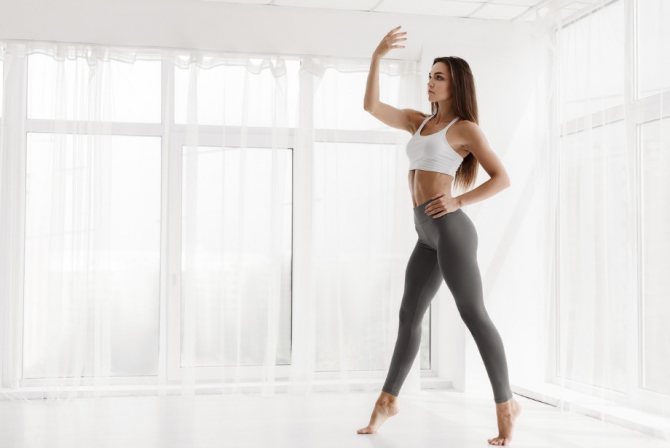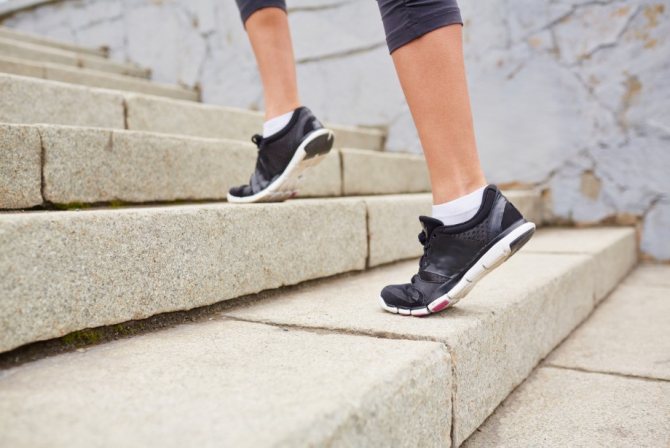According to statistics, almost 5% of young children periodically walk on tiptoes. Moreover, half of them, without any medical intervention, outgrow this habit by the age of 5.
However, many parents are concerned that their toddler does not step on his entire foot, but walks on his toes. What if this is a sign of some kind of disease that is important to identify as early as possible?
Let's try to understand this issue with the help of the famous pediatrician Evgeny Olegovich Komarovsky.
Why does a child walk on tiptoes?
“Moving a small child on his toes in most cases is not a pathology,” Dr. Komarovsky reassures parents.
Most often, the increased tone of the calf muscles “forces” the baby to stand on tiptoes. But the more the child walks, the faster the remaining ankle muscles develop. And then the little one will stand on his entire foot.
Read also: How to decorate a house for Easter: 6 step-by-step master classes
The second important reason for a child’s “ballet gait,” according to Komarovsky, is walkers. Very often, parents, having bought a newfangled device, forget to adjust it for their baby. Therefore, the baby is forced to spend a long time in a “half-hanging” position, resting only on his fingertips. It is not surprising that, having learned to walk, he will, out of habit, move on his toes.
In addition, Dr. Komarovsky names several more reasons for tiptoeing:
- The baby copies some characters from cartoons or TV shows.
- The floor in the room seems too cold or too dirty.
- He's just learning a new type of movement.
For parents who are very concerned about their child walking on their toes, Komarovsky gives advice:
“Buy your little one comfortable boots with hard soles. In them, the baby will not be able to stand on tiptoes and will quickly get rid of this habit.”
Why is walking on your toes good for your health? Scientists' opinion
When walking, we are used to leaning on our entire foot, and we switch to tiptoes only when we need to move as carefully as possible. For example, so as not to wake anyone up. Meanwhile, scientists have found that regular tiptoe walking has a powerful positive effect and even promotes weight loss.
We tell you how to walk to get rid of extra pounds.
Adaptive thermogenesis: why does the body resist weight loss?
Perhaps it’s not a matter of poor quality training at all.
How does a person walk?
A group of scientists from the American University of Utah studied the relationship between foot placement when walking and energy expended. At the beginning of each step, a person places his heel on the floor and then shifts his weight to his toes. People inherited this type of movement from monkeys, who usually do not travel long distances on the ground. However, in most mammals, the heel does not touch the surface while walking. For example, dogs and cats walk on the balls of their feet, while horses and deer walk on tiptoes.

Photo: istockphoto.com
According to scientists' hypothesis, ancient people retained this method of movement in order to save energy during long-term hunting on foot. After a study conducted by specialists, this assumption received scientific confirmation.
Which walk uses more energy?
27 volunteers took part in the experiment - mostly athletes aged 20 to 40 years. Each subject walked and ran in three different ways:
- with the foot landing on the heel;
- with the foot landing on the sole and the heel slightly raised;
- with a landing on the toes and a strongly raised heel.
Of the participants, 11 people performed the task wearing special masks that allowed them to control oxygen consumption. In addition, they walked on special plates that read the force with which a person presses on the ground when stepping. Another 16 volunteers were connected to equipment that monitored the activity of the muscles used during walking and running.

Photo: istockphoto.com
As a result of the study, the following results were recorded.
Firstly, walking with the foot on the heel is the most energy-efficient option for moving. This uses 53% less energy than walking on the balls of your feet. Those who walked on their toes expended 83% more energy than people who started their heels.
Second, walking on the balls of your feet increases activity in the core muscles of the ankle, knee, hip, and back.
Thirdly, when running, the difference in energy consumption depending on the way the foot is placed is minimal. Therefore, the standard method of human transportation is only economical when walking.

New normal. How much should a man and woman weigh at their age now?
Average weights have changed significantly recently, some will have to get back up to standard.
Why is this happening?
Scientists suggest that one of the reasons for the economical way of walking in humans is the unusual structure of the foot for mammals: a large calcaneus, a powerful and strong big toe, located parallel to the index.

Photo: istockphoto.com
“These traits are common in monkeys and provide the mechanical basis for an energy-efficient mode of walking. At the same time, humans spend more energy to run than most other mammals. We are well suited for running long distances, but human sprinting ability is lower than that of many animals. This is due to an energy-inefficient running style,” explains study leader and biology professor David Carrier.
What does it mean?
The results of the study by American and German scientists should help medical specialists, in particular in the fight against back pain. But the conclusions from this experiment also have practical applications. It turns out that tiptoeing helps you burn calories faster, as well as strengthen your ankles, back, knees and hips.

Running is not necessary. Why walking is better for health and weight loss
Scientists from the USA found this out back in 2020. Today their theory has many supporters.
Of course, you shouldn’t completely abandon your usual way of moving. However, walking on your toes every day for five minutes will strengthen the muscles involved in walking, and at the same time get rid of excess calories and get closer to your desired figure.
When should you see a doctor?
So, if a child walks on his toes only from time to time, there is no reason to worry. But when the baby constantly moves on tiptoe and this lasts for more than one month, there is cause for concern. Such a “balletomane” must be shown to doctors - a neurologist and an orthopedist.
First of all, because prolonged walking on tiptoes can cause atrophy of the calf muscles and Achilles tendons. In this case, the doctor will recommend a massage course for the baby, as well as special therapeutic exercises for the legs.
Unfortunately, sometimes walking on tiptoes (or on heels) is one of the manifestations of cerebral palsy or autism. Therefore, if a child has other alarming symptoms, you should immediately show him to a neurologist.
What are the reasons why a child walks on his toes?
Walking on toes is normal for children aged 2.5-3 years.
If the baby does not show symptoms of neurological disorders, then do not worry, he will stop walking like this on his own. But if a child walks on his toes, sleeps poorly, is passive and has poor coordination of movements, then you should contact a qualified specialist. Children over 5 years old should not walk with this gait.
Reasons for tiptoeing that are not alarming:
- trying to walk in different ways;
- desire to look taller than you really are;
- desire to attract attention;
- imitation of walking in heels;
- does not want to step on something;
- trying to reach something that is high;
- unspent energy that the child does not know what to do with;
- consequence of walking in a walker.
If the reasons lie precisely in this, then walking on toes will be periodic. Over time, the child will understand that walking this way is inconvenient and will forget this method.
Reasons for concern:
- muscle hypertonicity is the most common cause;
- pyramidal insufficiency (a disorder of the nervous system in which the walking reflex disappears, more often occurs in babies who had a breech presentation);
- Cerebral palsy (cerebral palsy);
- birth injury.
Increased muscle tone
Muscle hypertonicity in a child indicates increased nervous excitability. This disorder most often affects babies who suffered from oxygen deprivation during pregnancy, were born prematurely, were injured at birth, or have an emotional character or hypersensitivity.
Increased tone may be the first sign of cerebral palsy, so it is recommended to show the child to a pediatric neurologist at one month, three months, six months and one year.
It must be remembered that until the child is 3 months old, hypertonicity is physiological in nature and goes away on its own.
Pyramidal insufficiency
You can identify pyramidal insufficiency in a simple way - take the baby under the arms and hold him over the table so that the legs touch the surface of the table. Lean your child forward slightly. In this position, the baby should move his legs, standing on the table with the entire surface of his foot. If he does this, it means that the child does not have disorders in the nervous system, and if he rearranges his legs on his toes, then it is necessary to consult a doctor.
Signs of cerebral palsy
In addition to walking on tiptoes, cerebral palsy is accompanied by other serious symptoms. This disease can be diagnosed by every therapist.
The consequences of postpartum trauma cannot be cured without medical intervention and corrective procedures.
To find out exactly why your beloved child is walking on tiptoe, you need to consult a neurologist. After examining the baby, he will prescribe therapeutic exercises, recommend wearing a special bandage, or take other measures.
Some interesting facts about children's tiptoe walking
- The desire to walk on toes can be inherited. So, before scolding your child, ask your mother if you had such a habit as a child.
- You can get rid of the “ballet walk” faster if you walk barefoot on sand or sea pebbles every day.
- Some children even after 5 years continue to stand on their toes from time to time. According to survey results, most often they do this for no apparent reason, simply because they like it that way.
- Swimming classes help relieve hypertonicity from the ankle muscles and help the child stand on his entire foot.
What to do if your doctor insists on drug therapy?
Well, you don’t think that now we will give you a definite answer - “under no circumstances!”, or vice versa - “without hesitation, take everything that is not prescribed - the doctor knows”?!
In many European countries, doctors do not understand the essence of the problem of tiptoeing at all (we are considering only this individual symptom! Everything else is fine with the baby). “This is how they experience the world and test their capabilities.”
By the way, often controversially perceived by colleagues, Dr. E.O. Komarovsky is more likely to lean towards the Western position:
“The best thing you can do for your baby is to find him a doctor you trust, and then strictly follow all his recommendations. Do you doubt it? Consult with several more doctors, fortunately, now the compulsory medical insurance system allows you to do this.”
Good luck and patience!










